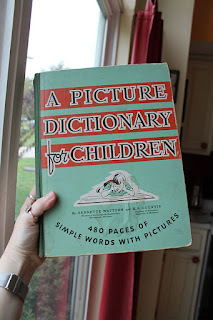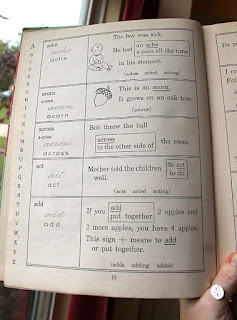The last time she did come with me, in any case, I found this illustrated dictionary that I thought she was going to rip from my hands, despite its remarkable lack of chair-ness:
Published in 1947, this dictionary epitomizes the didactic writing of the period. Dick and Jane aren't here, but it's their sort of world, start to finish. Father goes to work. Mother feeds baby. Puppy is naughty. Children have no trouble making friends. In this world, people are what they seem, and the moral choice is perennially clear and uncomplicated. My mother felt personal nostalgia for such a book because she had read books of this ilk in school, I'm sure, but I suspect she was also influenced (as millions are) by the broader cultural nostalgia, not for the books themselves, but for the world within them, a world that is frankly as fictional as any story, but which a majority of Americans collectively supposes to have occurred around and during the 1950s.
In this 2016 election season,we have heard a lot from a certain candidate about making America great again, like it was during that fifties. What specifically was great back then? Here's a good (if still flawed) list I found on the internet of the features of that great American society:
- A two-parent family in which the husband provides financial support while the wife manages home life and childrearing activities. Gender roles are absolute.
- Most (preferably all) members of the family attend some type of Christian church on at least a weekly basis.
- Children are attentive, respectful, bright, and responsible.
- Families live in the same town, or at least the same vicinity, for generations. Everyone knows their neighbors.
- Divorce is unheard of, and is considered shameful.
- Homosexuality, nonconformist behavior, child abuse, abortion, and domestic abuse do not exist.
- Unmarried couples are extremely rare, and frequently are shunned.
- The number of never-married men (“confirmed bachelors”) and women (“spinsters”) is extremely low.
Speaking of "othering," this list says nothing about segregation and racial discrimination, both of which were absolutely and pervasively present in the 1950s. Again, given the choice, individual members of the white heterosexual majority might not have acted to discriminate against or dehumanize individual Black people, but the majority did not criminalize lynching, let alone dismantle segregation or replace systems of oppression and exclusion. As Supreme Court Chief Justice Earl Warren recalled in his memoir, President Eisenhower once explained it to him like this: "These [southern whites] are not bad people. All they are concerned about is to see that their sweet little girls are not required to sit in school alongside some big overgrown Negroes." White men raped Black women with impunity from the time of America's founding through the Civil War and beyond, but white girls - the very symbol of purity - could not even be seated next to Black boys without the threat of eminent social collapse. Despite the Supreme Court's 1954 ruling in Brown vs. Board of Education, many southern states resisted and even flatly defied the order to desegregate. Alabama Governor George Wallace spoke the infamous words "segregation now, segregation tomorrow, segregation forever" almost a decade after Brown vs. Board of Education, in 1963, a few months before he blocked the door at the University of Alabama to prevent Vivian Malone and James Woods from coming inside. This problem was not exclusive to the American south, either. Boston - and particularly South Boston - is probably the best known example of de facto segregation north of the Mason-Dixon, but according to the Wisconsin Historical Society, "In January of 1976, Federal Judge John Reynolds ruled that Milwaukee Public Schools were indeed segregated unlawfully." As of 2010, New York had the most segregated schools nationwide (albeit, of course, "not intentionally").
To the list of eight characteristics of America's past "greatness," then, I will add:
9. Segregation is acceptable, if not actively preferredFor all these reason, when I see a hat that says "Make America Great Again," I see a longing to have the majority go unchecked by any consideration other than its own comfort and happiness. I see a demand that psychological peace and linguistic freedom be purchased for a white heterosexual patriarchal majority at any cost, including those of civil rights, freedoms, and lives. When I see or hear "Make America Great Again," I want to problematize that whole idea, as I have just done. But I'm thinking I have more than words at my disposal.
10. Civil rights violations, state violence, disenfranchisement, and lack of access to opportunities are of no real consequence so long as they do not impact the majority
Circling back around to A Picture Dictionary for Children (remember that?), each word in the dictionary has a definition and a sentence using the word. I was flipping through the book last weekend when I noticed that Bob seemed to come up a lot in these sentences. Like, A LOT. In fact, I counted, and Bob is used in 160 different example sentences in the dictionary. Thus was born my idea for "The Bob Project," in which I will illustrate sentences from the dictionary in ways that problematize nostalgia for America's bygone greatness. If this sounds like it interests you, I'm doing it from now until the election, so grab a chair and click on. Also, speaking of that chair, my mother wants to have a look.
First Entry
Second Entry
Third Entry



You are truly wonderful! I love to read everything you write. I've actually known about Christine Jorgensen for years, but had forgotten about her. Indeed, let's make America great again!
ReplyDelete